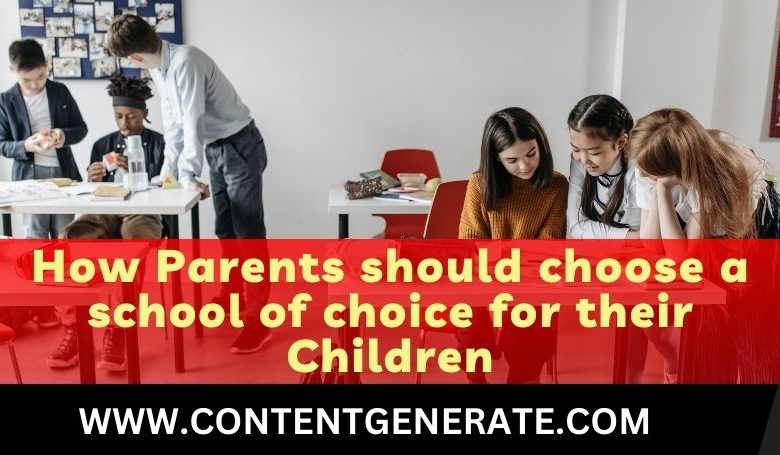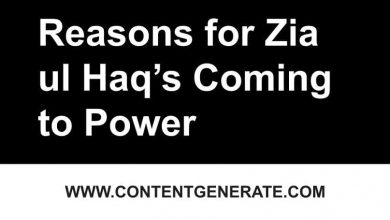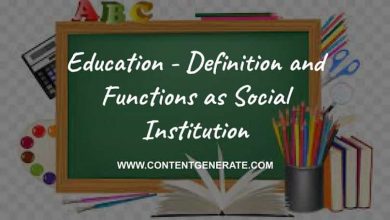
The following article describes the main indicators that parents must consider before opting for a school of choice for their children esp. in private sector.
Choosing a school of choice is vital because our children’s future is highly dependent on the opted school and as a client(parent) and service provider(school) the relationship remains for decades.
School choice is a complex concept, and as corresponding policies may take various forms, one cannot isolate one single measure of the prevalence of school choice. One may consider several types of measures and indicators.
I will start my article with a story of a parent struggling to search for the best school for their only child. It was one of my ex-pat clients who asked me to suggest a school for their 3 years son in Lahore. My client was fortunate enough to afford all the branded schools in Lahore, so I provided a list of the top 10 expensive schools in his vicinity. He browsed the list, googled them all, and was not satisfied with any of the recommended schools. He asked me, “what makes them good schools?” I answered, ‘your affordability’. He then asked me what makes them so expensive. I had no answer to this second question. His next question was more complex. Schools are established to provide a better teaching-learning environment for children, out of the 10 recommended schools, which one has the best teaching and learning environment? I had no answer, I just looked down without any response.
Parents contact me requesting for making appointments with the schools I suggest to them for admission of their children. Once I accompanied parents (mother and father) along with their son as they were visiting one of the schools I had recommended. They wanted to visit the school and see whether it reflects their wishes or not. I was astonished to see the marketing skills of young women working for the schools. They were so attractive that a normal person will mostly fall in love with them. However, my clients were more oriented toward their goals of adopting the best school for their son. To my surprise, the parents only took a brochure from each school while ignoring the ambiance (mostly like 5-star hotels) and the beauty of teachers cum marketing persons. At each school, the parents politely excused the welcome given to them by the school. At each school, I saw them visiting the washroom of the school.
At the dinner table, I asked them which school they have chosen for their son. The mother desperately said none of the schools was good enough to educate their child. I inquired what was the reason for this negative remark because you people only spend 3 minutes with the principals and 3 minutes in the washroom. Their answer was very much rational “These schools are only good at marketing their product. In three minutes with the principal, we realized that their negotiation started with fees and discounts. In their three minutes conversion, we didn’t hear a word about pedagogy and teaching-learning, the core purpose the schools are built for. We intentionally took our son to the washroom because that is the least priority area that parents would like to visit. We were also not happy with the hygiene and age appropriateness of the washrooms. The schools only show us what they can sell ignoring what the parent community need is. These schools are spending a lot on marketing while ignoring investment in teachers and the well-being of the students. These people are so much trained that they can easily deceive us in changing our minds if we had given them more than 3 minutes”. The family migrated to Singapore just to educate their child in a school of choice.
Since the creation of the school brand, the schools have mostly focused on selection criteria rather than its core purpose of teaching and learning. The skimming is done through the admission tests and the residential addresses (to ascertain the financial status and the society where they live).
Shahid Ali Aman
The privatization of education and the profitability of the education systems have promoted numerous options for families to choose a school. The controlling authorities in public sector education i.e. education district offices, have not been able to take appropriate steps to make each school compliant with them. The school registration form is vague and ineffective to administer and monitor the schools. Hence, there is no regulatory authority in the education sector to address service providers’ and clients’ needs and grievances.
The branded schools have also leverage to select their students. Their approach focuses on the extent to which parents can exercise some form of school choice. For example, schools may, select students based on socio-economic status, ethnic/religious group, or academic abilities. Such schools are unethical because they temper the competitive market by selecting the brightest. After all, the probability of positive outcomes is high. Since the creation of the school brand, the school has mostly focused on selection criteria rather than its core purpose of teaching and learning. The skimming is done through the admission tests and the residential addresses (to ascertain the financial status and the society where they live). The schools that choose students shall realize that they are not promoting a competitive market, and, in their case, the success credit must be given to the students and their families because they have done what they were made for without any constraints.
Since the creation of the school brand, the school has mostly focused on selection criteria rather than its core purpose of teaching and learning.
As private schools are also for-profit, market principles of demand and supply also work in the education sector. Both the demand and supply-side should meet an equilibrium point. However, the majority of the parents(clients) have very less information about the service providers (Schools).
To simplify the article, we will use the law of demand and supply: the demand side is parents/students, and the schools are referred to as the supply side because parents pay for the services they avail from the schools.
Following are the sequence-wise top eight indicators for selecting the school.
Contents
1. Financials
There is a huge variation in the tuition fees of private schools. In cities, the monthly tuition fees range from Rs. 4000 to Rs.70,000. According to the thumb rule, 25% of the household should be invested in education and health in a family. The key assumption of the thumb rule is that the household (HH) income should be 25% above the minimum wage rate prescribed by the government in response to inflation. Currently, if the HH income is less than Rs. 25,000, private schools are not a viable option for the family. Similarly, if the household income is Rs. 100,000 then a family can select a school charging 25,000 for one sibling, and if there are 2 or more siblings the same amount (25000) must be equally distributed. The remaining Rs.75,000 can be spent on other necessary components i.e., food, accommodation, utilities, mobilities, and health.
2. Distance of the School
In Pakistan, a few schools have boarding options. Moreover, schools have been established according to the paying capacity of the parents i.e. schools with high tuition fees will not be established in slum areas. The second criterion in selecting a school will be the availability of safe, quick, comfortable, and affordable commuting for the student. Ideally, less than 10 KM distance is viable for young children to travel to the school via vehicle.
3. The Ideological Affiliation of the Schools
In Pakistan, there are large numbers of private schools that have religious, sectarian, and political affiliations. These private schools are biased toward their affiliated communities and try to promote their ideological beliefs in society. For example, some schools are directly and indirectly supervised by the armed forces and people associated with the army institutions get certain privileges in educating their children in the system.
I remember visiting a few schools in Punjab, Sindh, and KPK for research on quality schooling. I was astonished to observe that many schools restrict their admissions to particular sects or community. Moreover, their curriculum and pedagogy were more inclined toward the ideology of the school hardly known outside. During my visit to many schools, we heard dua (prayer) for starting the day and before taking lunch by the students. We saw non-Muslim children also reading the same verses. Especially minorities are isolated both by their parents and students. This points towards the fact that most of the students are not encouraged to embrace diversity and inclusiveness.
Parents must be vigilant enough in determining the schools because there are very few options for liberal institutions in Pakistan. The school names also indicate the ideology of the school, i.e., if you do not want to enroll your children in conservative institutions, you still have many other choices to make.
4. School offering Life Skills, ICT Skills, and Global languages
As a parent, at the time of admission, we can take a round of classrooms and review the normal timetable of the school. The timetable must be reviewed to ensure that the school has periods/units for the development of life skills, computer sciences, and languages.
Schools that have science/computer labs, libraries, language rooms, and life skills rooms must be given priority.
5. Curriculum and Assessment
Curriculum decision-making contributes to each child’s learning and development outcomes concerning their identity and connection with the community, well-being, confidence as learners, and effectiveness as communicators.
In Pakistan, most schools follow the national curriculum with different levels of integration. Schools can be affiliated with different local boards (district/city level boards), national boards (Federal and AKE-UB), and international boards (Cambridge and IB). The difficulty level increases from local to national and then to the international level. The retention rate is very much high in the local boards because of a lack of transparency and easy level of content as compared to the national and international boards.
Parents must look for a school that suits the learning level of their child, parents can give weightage to either high learning outcomes or exam grades. Higher grades have a high probability of admission to public sector institutions while high learning outcomes have a higher probability to earn international scholarships and it has higher compatibility for the private sector.
6. Learning Outcomes of Children
It is always difficult for parents to gauge the learning outcomes that the school is contributing to. A simple measure to gauge the learning outcome can be to analyze the success ratio of alumni because they are the true ambassadors of the schools. If as a parent, you are inspired by the graduates of that school then it will always be a favorable place for your child.
7. People Involved in the Teaching Process
In Pakistan, licensing for teaching is not available so the guarantee of having good teachers is not ensured. Currently, the graduates that most Pakistani universities are producing lack content knowledge which is why the reliability of the degree is also a question mark.
Moreover, mostly schools’ teachers are not allowed to talk to the parents. However, staff behavior and motivations can be analyzed during the search process. If staff are not welcoming and seems less motivated, then you need to switch to another place. The other way to gauge the learning process can be by probing their satisfaction level with teaching and learning.
Staff turnover also matters, as per management practice, more than 3% turnover is not healthy for any organization. High turnover is mainly associated with dissatisfaction and demotivation of teaching staff. Such data is confidential and not disclosed by the school management. However, we can get the general feeling by asking the number of new teachers engaged during the academic cycle, again if that is high search for a school that has a lower teacher turnover of less than 3%.
Other Factors
Nowadays, infrastructure and school building are not vital because the core business of the schools is to provide quality teaching and learning. Research shows that more investment must be done in teachers’ motivation and quality while the keeping all other factors supplementary.
Keeping the above sequence, the following factors may also be taken into consideration while selecting a school:
- Class Size should not be over 30 students
- Parents shall be engaged in the learning process from day one and both work as a partner in the well-being of the child
- The school ensures the security of the students
- The school is compliant with govt institutions
- The school is inclusive and acknowledge students from diversities background
- The school is open to providing all information regarding policies
The writer is a development sector consultant and a highly trained professional who provides expert advice and support to individuals and organizations in the education sector. With this knowledge, skills, and experience he has developed and implemented strategies for improving educational outcomes and ensuring the success of students and educational institutions.



